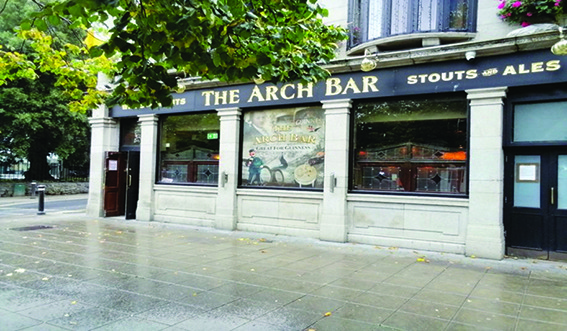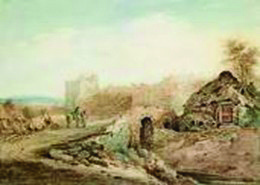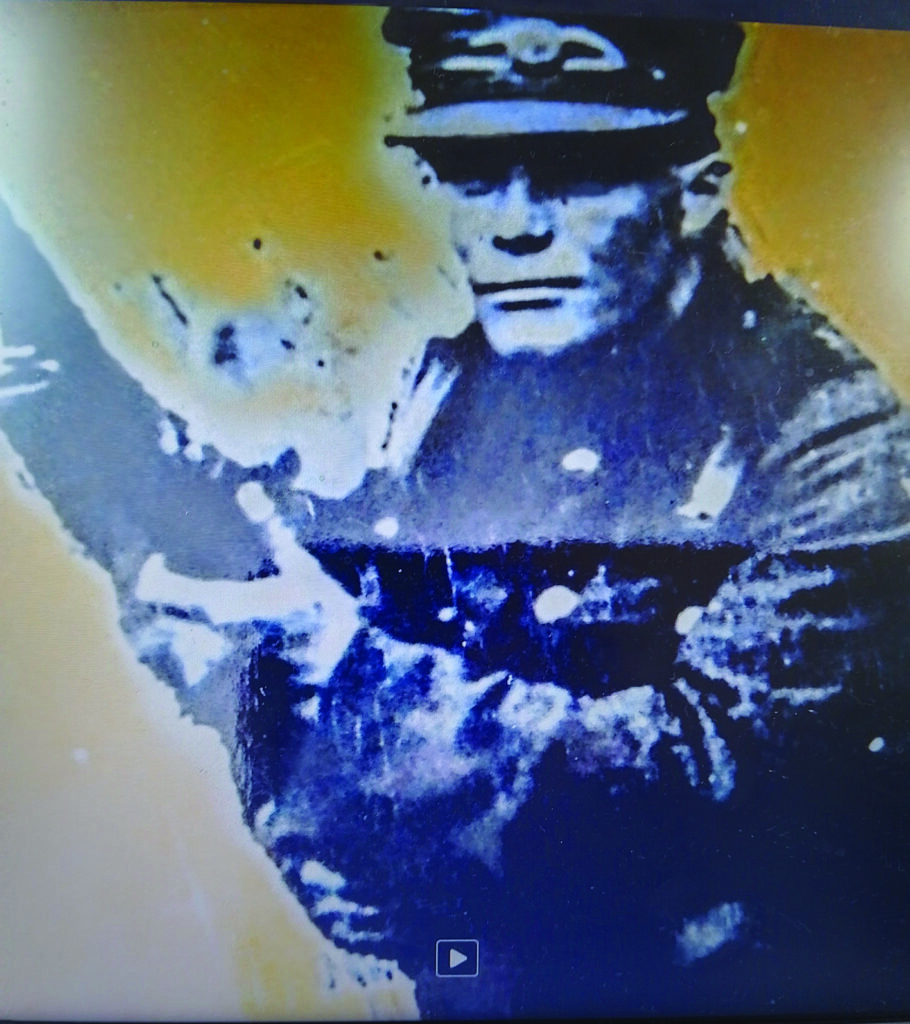With it’s different names over time, the present-day Arch pub has always played a pivotal role in the social life of Swords. Burnt by the Black and Tans in 1920, it’s granite facade still features some bullet-holes dating from that troubled era of Swords history.
The earlier photo shows that another business, a harness-makers shop, was originally attached to the main building, as well as a ‘jostle-stone’ to stop cartwheels striking and damaging its wall. These vertical stones can be found in many of the back lanes of Swords. These particular structures were removed when Chapel Lane was widened for modern traffic.
The eponymous star above gave it’s name to this business in the modern age.In the 80s and 90s, many older Swords folk looked forward to their Sunday roast carried home to them from the Star!
The ad in the left window is for DWD, the Dublin Whiskey Distillery, a famous distiller founded by master distiller John Brannick in 1872.His distillery was located on Jone’s Road and ushered in a golden age of Irish whiskey making. Amazingly, this venerable business was revived in 2017, some 71 years later, continuing a long and honerable tradition of distilling in Dublin.
The modern business here continues Sword’s long and proud tradition of hospitality and friendliness to all customers. Cheers!!

The Ward River has powered many water-mills in its time, the volume and flow of the river having been historically much stronger than we see in it today. Before the age of steam, wind and waterpower were the only sources of energy available. In 1847 there were 3 mills working from the Ward. This particular one operated well into the 1940s, many of our older residents remembering it’s nostalgic resonant grumbling and grinding sounds!
The bridge itself dates from 1875 and is made of cut limestone with very distinctive ‘saddleback’ coping. Next time you are down this way, look down into the river to see a string marking the historic levels of water here. Down on the left at riverside you will also see the typical entry-piers I’ve cleaned, placed here to allow access to the river for washing clothes or drawing water. These piers appear all along the Ward to allow safe access to a once powerful and dangerous stream.

The following is an extract from Mike Power’s forthcoming book - Swords: History and Mysteries… A Community Guide
Despite being situated solidly within the ‘Pale’(‘Pallium’ latin=A Fence) the spirit of Irish nationalism was never quite extinguished in Swords and Fingal…Swords folk contributed to every insurrection in Ireland, most notably in 1916, when the Fingal brigade of the Irish Volunteers led by Captain Richard Coleman of Main St. fought bravely in the engagement in the Mendacity Instit, Dublin.Swords folk can be very proud of it’s long and honourable tradition of nationalism, often carried out in the face of great opposition from the authorities. Fingal Abu !
‘Fingal has done more than its share in Ireland’s republican cause…’
Eamonn de Valera 1940
Easter Monday 1916 in the village of Swords dawned fine and dry. The Taylor brothers Tom, Joe and Christopher left their home in Taylors’ pub, Main Street, and headed out toKnocksedan bridge, half-an-hour’s walking at their brisk military pace. While confused by Eoin Mc Neill’s letter in the Sunday Independent to stand down, they still held to Captain Richard ‘Dick’ Coleman’s order:
‘We meet at Knocksedan Bridge on Monday, Ok?’
Their new boots chafing their feet as they strolled, going up the Brackenstown Road, they met Christopher ‘Kit’ Moran.
‘Is it still on?’ he asked, the others, saying nothing, walking stolidly ahead.
Kit Moran’s Mauser rifle slapped rhythmically on his hip, ‘damn blunderbuss,’ he spoke as he walked, knowing well the horrid mess its 57 mm. rounds could make of something as fragile as the human body. Seventy men were already waiting on the bridge, most smoking and cooling their heels, their mood black, disappointed with the poor turnout.
Some peered over the parapet at the black pools of water 60 feet below, pondering what lay ahead.
Finally, Captain Richard Coleman arrived, his Sam Browne belt and brass buttons shining in the shafts of sunlight scattering on the bridge. Pointedly, taking each man in with his eyes he said: ‘Right then, a Oglaigh, this is what we did all that hard training for – this is the day!’
Dublin writer George Fitzgerald is no stranger to putting pen to paper and with firm roots in Swords, George fondly remembers his relative Ned Stafford who was an integral part of the Nationalist movement and an active participant in the 1916 Rising.
Ned Stafford from Swords, County Dublin. His mother, Brigid Stafford, described as “a lady,” was supportive of his nationalist beliefs. The Stafford parents and their nine children are buried in Swords Cemetery. Ned became involved in nationalism after hearing Thomas MacDonagh speak at a gathering in Swords. Once he had made his decision, his mother supported him, and the family was aware of the key figures involved. Ned Stafford was present at Boland’s Mills during the 1916 Rising.
Boland’s served as a crucial strategic location for the Irish Volunteers. The mill, along with other buildings in the area, became the headquarters for the 3rd Battalion, which was tasked with controlling key approaches to Dublin from Dún Laoghaire, then Kingstown, a port where British reinforcements were expected. The Volunteers engaged in fierce fighting, particularly at Mount Street Bridge, and successfully held their ground against British forces until the order to surrender was given.
Ned subsequently enlisted in the Free State Army. However Private Edward Stafford died due to tuberculosis acquired during active duty in 1926. In a letter from his mother, she expressed her pride in stating that her son fought during Easter Week under Risteard Mulcahy’s command.
Ned Stafford’s dad, Patrick, was employed as a gardener. Three of his sons enlisted in the Irish Army. George Stafford was a member of the Irish Army from 1927 until 1960. The Black and Tans, or perhaps British troops, during the War of Independence, while they were looking for Ned Stafford, who was fleeing. He was informed that the plans for Ashbourne were concealed within the house, intended to prevent the train from transporting soldiers into the city. One of his brothers was Tom Stafford, who in the 1930s lived in a tenement in Gardiner Street, Dublin, in the 1930s. He and his family later moved to Ballyfermot. His daughter, Maria, married a local man, George Fitzgerald. In 1966, the young couple got a new flat on the tenth floor of the newly developed Ballymun flats.
George Fitzgerald is the author not only of the Ashley Brown series but the 9-book audiobook series about growing up in Ballymun in the 60s and later his life in Finglas South. There were four brothers in the family: George, his twin Joseph, Pat, and Wesley. The twins were champion boxers in the 70s. And band members in the 80s and 90s with the famed D11 Runners. The audiobooks can be listened to on YouTube or Facebook.

Malahide Historical Society has recently unearthed wonderful images of ‘Hogan’s Top Shop’ Hogan’s grocers, wine and spirits merchants stood for many years on Main Street at what is now Malahide Credit Union premises. Locals called it Hogan’s Top-Shop to distinguish it from Hogan’s Bottom-Shop, their other premises on New Street (now Fowler’s pub).
Two of these three fascinating images have just recently come to light showing deliveries in the early 1900s. The truck is a Guinness lorry outside the premises circa 1910. (photo courtesy of Richard McAllister)
The third image, also from about 1910, shows a cart with the name ‘Bewley & Draper, Ink Makers’. This was a business owned by a branch of the famous Bewley coffee family which imported chemical and ink supplies as well as, unusually, mineral waters. It is likely the cart was being used to deliver not ink but mineral waters to Hogan’s as indicated by the crates on the footpath under the awning into which a worker appears to be peering.
Thanks to Malahide Historical Society.


Calling all history buffs! Join us at Malahide Castle for an Oral History Open Day in celebration of Heritage Week 2024 on Saturday 24th August. This is a fantastic opportunity to share and listen to stories about the Talbot family and Malahide Castle from yesteryear in an open mic-style setting.
Here’s what you can expect: Share your personal stories: We want to hear your unique perspectives on Malahide Castle’s rich history. Uncover hidden gems: You might be surprised by the fascinating stories waiting to be unearthed! Connect with the community: Bond with fellow history enthusiasts and create a tapestry of Malahide Castle’s past. Contribute to history: Your story becomes part of the ongoing narrative of Malahide Castle.
Got some pictures and memories? - We want you to share them with us!
Help us build our understanding of the castle’s history by adding to the narrative. Whether you have a story to tell or just want to listen, everyone is welcome.
The event is free but spaces need to be booked by visiting: www.malahidecastleandgardens.ie/heritage-week-oral-history-open-day
Courtesy of Malahide Historical Society
At this time of year in the 1830’s, it was popular in the past to take ‘the pledge’ after the Christmas excesses. The Pledge was a commitment not to take alcohol and was inspired and promoted by The Total Abstinence Society founded by the famous Fr Theobald Matthew in 1838. He paid a high profile visit to Malahide as part of the celebrations for the opening of St. Sylvester’s Church in July 1846, as recounted in the Freeman’s Journal:
“We perceive that the new Catholic church of Malahide will be dedicated upon Sunday next. The ceremony—the most interesting, perhaps, of all those by which the Catholic church stimulates—and elevates the piety of her children, will be performed by the venerated prelate of this diocese, the most Rev. Dr. Murray. The dedication sermon will be preached by the Very. Rev. T. Matthew. We understand that the completion of this holy edifice depends in a great degree upon the amount of the contributions which the congregation on this occasion may be pleased to bestow.The district of Malahide is far from wealthy, and the people have contributed already to the full extent of their means. The Right Hon. Lord Talbot De Malahide, with great liberality, as well of means as of mind, generously contributed one hundred pounds to the building fund, and we understand his Lordship has promised a further subscription at a future period. We have no doubt that the appeal of Sunday next will enable the excellent Catholic rector, the Rev. Mr. Fleming, to proceed in his good and pious work, and to complete a beautiful edifice dedicated to the service of the Almighty Father of all.
A Select Choir will attend, under the management of Mr. Gormley, of Saints Michael and Johns’ Church. Admission to the Sanctuary for a family of Five is £1; Individuals are 5s. each Admission to the body of church, 2s/6d each. The Very Rev. Mr. Matthew will administer the Pledge after the ceremonies of the day. Increased accommodation will be afforded on the Railway”. It is not recorded how many took the pledge in Malahide that day but at its height, just before the Great Famine of 1845–49, his movement enrolled some 3 million people, or more than half of the adult population of Ireland.
Courtesy of Malahide Historical Society
The current movie blockbuster on the life of Napoleon Bonaparte reminds us of Malahide’s (slight) Napoleonic connections.
On Church Road, Manor Books is housed in Manor House, which dates from the late 1700s and was the one-time office in the village for handling the affairs of the Lord of the Manor, Lord Talbot de Malahide, who owned the ground rent and much of the properties. Lord Talbot’s agent or bailiff would manage village affairs such as collection of rents and meetings with tenants. Up to the early 1800s it was the site of the Manor Court which dates from a time when the local landowner held a degree of legal jurisdiction over his properties and tenants and was the lowest level in the courts system. In here, minor legal and petty crime cases would be heard and when the building was being refurbished in the 1990s the remains of a holding cell were found.
For a time in the early 1800s Manor House was home to an adventurer and United Irishman grandly named Herve Morres de Montmorency who fled to France after the failed 1798 rebellion and achieved a commission in the French Army under Napoleon Bonaparte who is said to have been an admirer of Napper Tandy and Montmorency and interviewed him personally. Up to his death in France in 1839 he remained wanted by the British forces.
At The Diamond, the house, which up to recently was the Ulster Bank, was in the 1780s the home of John Fortescue who was married to the sister of Arthur Wellesley, an officer in the British Army who later became the Duke of Wellington and defeated Napoleon at Battle of Waterloo in 1815. Wellesley is believed to have been a regular visitor to his sister in Malahide.
On the Coast Road, Hick’s Tower, with its ‘witches’ hat’ roof added in 1911, was a Martello Tower, one of around 50 such watchtowers around the Irish coast built by the British to watch out for French invasion forces during the Napoleonic wars.

By Jon Kavanagh
My earliest memory sees my mother lighting an oil lamp on a winters evening. It’s the 60s. JFK is in the White House, there are satellites circling the earth, radio Caroline is blasting out pop music from international waters and Bob Dillion tells us The Times They Are a-Changin’. But there’s not much evidence of change in our neck of the woods. Although the gate lodge where I’m spending my formative years is only a few miles from Swords and Dublin Airport, there is no running water or electricity. My father does a circus clown impression as he cycles home from the roadside pump, steering with one hand whilst precariously balancing a bucket of water with the other one. We toilet alfresco. Our humble abode which makes Steptoe and son’s den look like Home of the Year, consists of a kitchen and one tiny bedroom, separated by a wooden partition which stretches half way to the celling. The ice-cold blue flag stones on the kitchen floor serve as a barometer, turning damp when rain is on the way. An open fire multi tasks as a cooker, heater, clothes airer and bread toaster. Double glazing is a sheet of ice on the inside of the window. Home insulation is a sack slung across the bottom of the door to repel the easterly breeze. The duvet is an ill matched pile of blankets and overcoats. Heavy army coats are much sought after for bedding purposes. We live on the edge of a wood which has a healthy population of wild life. Bats, various insects including daddy longlegs, mice and the odd rat are familiar visitors. For reasons best known to himself, a rouge rodent decides to make off with my mother’s false teeth. Luckily, his lack of manual handling skills does not allow him to manoeuvrer them through his exit point and he is forced to abandon his loot. There is a temptation to look back through the lense of today and feel one had less than an ideal childhood. But my rustic upbringing gave me a reservoir of resilience. A resilience I was very glad to tap into when the covid lockdowns came.
There have been TV and radio programmes recently featuring the late Dr. Noel Browne. As Minister for Health, Browne is credited with waging a successful total war on Tuberculosis. However, his attempt to implement the Mother and Child Scheme in effect brought down the First Inter-Party Government of Taoiseach John A. Costello in 1951 and remains one of the greatest political controversies in modern Irish political history. One radio programme included Liveline on RTE Radio 1, Wednesday August 2nd., featuring artist Robert Ballagh, whose portrait painting of Noel Browne is hidden away in storage. Among other details mentioned in that broadcast was that Dr. Noel Browne lived in Malahide for 6 months each year! Does anyone know or have any more details/information on where in Malahide he lived or any details of his life here? If you have you can contact Malahide Historical Society on their email at: malahidehistoricalsociety2@gmail.com (courtesy of Malahide Historical Society)
